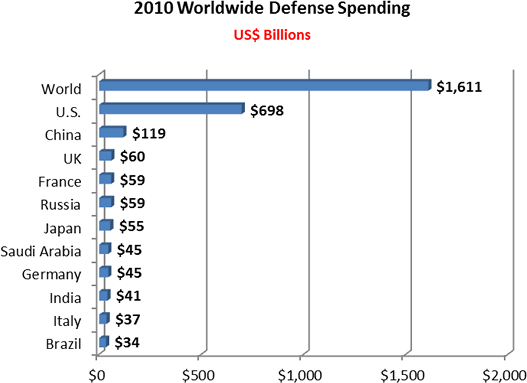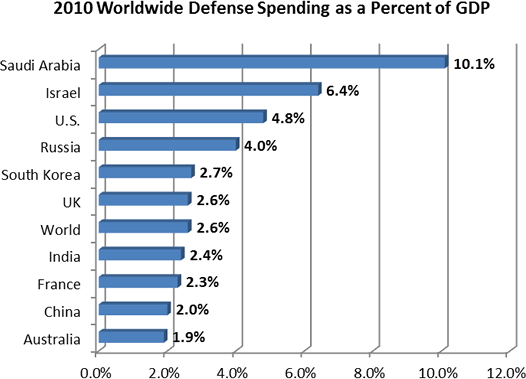The Military/Aerospace Market for Cable Assemblies Sees a Cloudy Forecast for 2012
 The military and aerospace industry is continuing to experience the downward pressures of a challenging economy.
The military and aerospace industry is continuing to experience the downward pressures of a challenging economy.
Military budgets have proven buoyant over the past few years, driven by the wars in Iraq and Afghanistan, and by higher spending by developing countries. Now the main drivers of military demand — threats, politics, and the economy — are signaling tough times ahead for this sector.
The military/aerospace equipment sector recorded a sales increase of 6.4% in 2010. The companies that Bishop tracks in this market segment grew an average of 2% in 2011 over 2010, and the combined net income grew 5.8% year-over-year. Of the 13 market sectors that Bishop tracks, military/aerospace was second-slowest growing. Net income as a percent of sales totaled 6.8% for 2011, up 5.8% year-over-year.
While the military/aerospace business of some companies fared well in 2011, like Boeing, Honeywell, Textron, and United Technologies, other companies, such as Finmeccanica, Northrup Grumman, EADS, and L-3, struggled with the changing environment.
Mil/Aero Equipment Sector – Sales and Net Income

Quarter-to-quarter (4Q11 versus 3Q11) sales increased 8.3%. Year-over-year, sales decreased -1.2% in the fourth quarter.
Worldwide Defense Spending Trends
In 2010, according to Stockholm International Peace Research Institute (SIPRI), $1,611,437 million was spent on defense worldwide. The U.S. represents 43% of that spending. The next 10 largest defense spenders by country, including China, total 34% of the worldwide spend.

Source: Stockholm International Peace Research Institute (SIPRI)
As a percent of each country’s Gross Domestic Product (GDP), Saudi Arabia is the top spender at 10.1% and Israel at 6.4%. Note that worldwide, 2.6% of GDP is spent on defense. Of the top 10 countries, six countries spent more than the world average.

United States Defense Spending Trends
The U.S. administration and congressional constituents have agreed upon defense budget reductions in the order of $487 billion over 10 years. The U.S. defense budget is still the largest in the world, accounting for approximately 43% of global defense procurement. In 2010, the U.S. spent $698 billion on defense. Every year the U.S. Department of Defense (DOD) goes through a complex process to establish and finalize its budget. The first stage in the process is the submission of the Presidential Budget (PB). The FY2013 PB for DOD is $613.9 billion, split between $525.4 billion baseline and $88.5 billion Overseas Contingency Operations (OCO). Among the large line items, procurement is hit the most, with a $12.1 billion decrease (-10%). Operations and maintenance contribute almost the same decrease, with an $11.2 billion loss. Significant changes include:
Terminations:
- Global Hawk Block 30 (a variation of Block 40 receives funding)
- C-27J Joint Cargo Aircraft
- HMMWV recapitalization
- Defense Weather Satellite System (DWSS)
- C-130 Avionics Modernization Program (AMP)
- Medium Range Maritime UA
Program Restructuring:
- Joint Strike Fighter
- Ground Combat Vehicle (GCV) Program
- Family of Medium Tactical Vehicles (FMTV)
- Ohio Class Replacement-SSBN (X)
- Joint Air-to-Ground Missile (JAGM)
- Joint Land Attack Cruise Missile Defense Elevated Netted Sensor (JLENS)
- Shipbuilding
- Rephased Aircraft Procurement: P-8A Poseidon, MV-22 Osprey, E-2D Advanced Hawkeye
European and Asian Defense Spending Trends
- Asia is expected to outspend Europe for the first time in 2012. According to the International Institute for Strategic Studies, Asia spent $262 billion on their defense budgets in 2011, while the European NATO members spent approximately $270 billion. They estimate that China currently accounts for 30% of the spending, or roughly $80 billion.
- IHS Jane’s, an industry consultant, estimates that by 2015, China will spend more on defense than the top half of the European NATO members.
- Europe’s military spending picture was highlighted during the Libyan campaign by the shortages of support aircraft, munitions, and reconnaissance capabilities.
- Estonia and Poland are the only two Central European countries that will meet NATO’s military spending commitments in 2012.
Impact on the Interconnect Industry
Bishop projects the interconnect industry growth at 3.5% for 2012. The military/aerospace sector for cable assemblies is expected to grow 1.7% in 2012. What happens in 2012 and beyond is dependent on the outcome and progress in many areas:
- Sovereign credit crisis in Europe
- High deficit spending in Western economies
- Slowing economic growth in China and Asia Pacific
- China’s economic resolve to modernize their defense
- Social/political unrest in the Middle East, particularly Syria, Iran, and Egypt
- High inflation rates in China and India
Bishop & Associates projects the worldwide market for military/aerospace cable assemblies to grow to $14.4 billion in 2012. The majority of the growth will be in China, Asia Pacific, and ROW, where the expansion will be between 5% to 8%. North America and Europe are anticipated to be flat to 2011.
No part of this article may be used without the permission of Bishop & Associates Inc.
If you would like to receive additional news about the connector industry, register here. You may also contact us at [email protected] or by calling 630.443.2702.
- Facts & Figures: Semiconductor Market Grew to a Record $336 Billion - March 2, 2015
- TLC and Metz Ethernet Cat 6A Patch Cords in Seven Vibrant Colors - January 27, 2014
- Cables Unlimited LC-LC Duplex Ruggedized Fiber Jumpers - January 27, 2014

